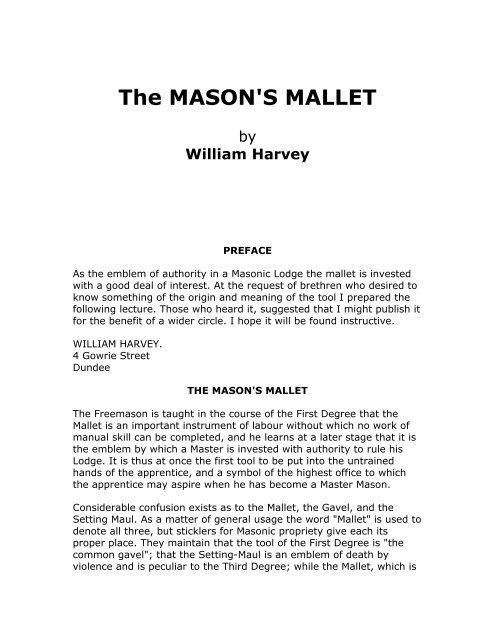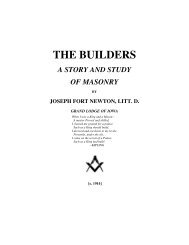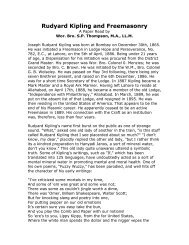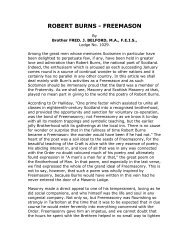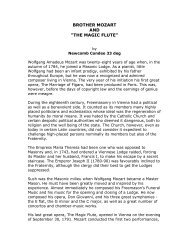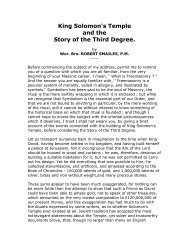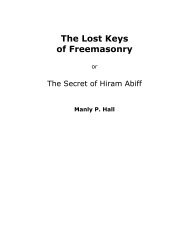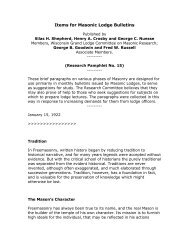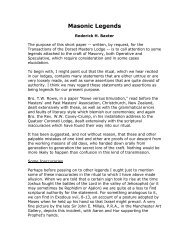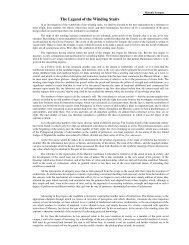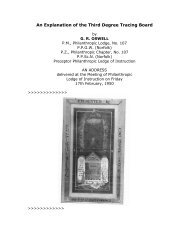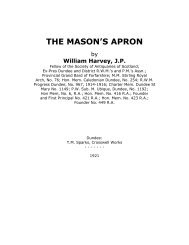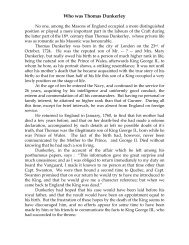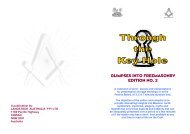The MASON'S MALLET - RoseCroix.org.au
The MASON'S MALLET - RoseCroix.org.au
The MASON'S MALLET - RoseCroix.org.au
Create successful ePaper yourself
Turn your PDF publications into a flip-book with our unique Google optimized e-Paper software.
<strong>The</strong> <strong>MASON'S</strong> <strong>MALLET</strong><br />
by<br />
William Harvey<br />
PREFACE<br />
As the emblem of <strong>au</strong>thority in a Masonic Lodge the mallet is invested<br />
with a good deal of interest. At the request of brethren who desired to<br />
know something of the origin and meaning of the tool I prepared the<br />
following lecture. Those who heard it, suggested that I might publish it<br />
for the benefit of a wider circle. I hope it will be found instructive.<br />
WILLIAM HARVEY.<br />
4 Gowrie Street<br />
Dundee<br />
THE <strong>MASON'S</strong> <strong>MALLET</strong><br />
<strong>The</strong> Freemason is t<strong>au</strong>ght in the course of the First Degree that the<br />
Mallet is an important instrument of labour without which no work of<br />
manual skill can be completed, and he learns at a later stage that it is<br />
the emblem by which a Master is invested with <strong>au</strong>thority to rule his<br />
Lodge. It is thus at once the first tool to be put into the untrained<br />
hands of the apprentice, and a symbol of the highest office to which<br />
the apprentice may aspire when he has become a Master Mason.<br />
Considerable confusion exists as to the Mallet, the Gavel, and the<br />
Setting M<strong>au</strong>l. As a matter of general usage the word "Mallet" is used to<br />
denote all three, but sticklers for Masonic propriety give each its<br />
proper place. <strong>The</strong>y maintain that the tool of the First Degree is "the<br />
common gavel"; that the Setting-M<strong>au</strong>l is an emblem of death by<br />
violence and is peculiar to the Third Degree; while the Mallet, which is
a miniature of the Setting-M<strong>au</strong>l is one of the working tools of a Mark<br />
Master. This arrangement is the one favoured by Bros. Mackey and<br />
Peck in their "Lexicon of Freemasonry," but sometimes they come<br />
perilously near to contradicting themselves, and if all they say is<br />
subjected to strict examination flaws in their arguments become<br />
apparent. Bro. Mackey insists that what he calls "the common gavel" is<br />
one of the working tools of an Entered Apprentice and says that "the<br />
true form" of it "is that of a stone-mason's hammer. It is to be made<br />
with a cutting edge that it may be used to break off the corners of<br />
rough stones,' an operation which could never be effected by the<br />
mallet." While this may be true, and while the work of breaking off the<br />
corners of the rough ashlar might be of a kind to which the apprentice<br />
operative would naturally be turned on beginning his trade, the cutting<br />
edge of the tool clearly implies the absence of the chisel. Bro.<br />
Mackey's book deals, for the most part, with things as they are in<br />
America, and as, I understand, the chisel is not a tool of the First<br />
Degree there the point does not arise, but in Britain where the chisel is<br />
presented it cannot be used along with another tool that has a cutting<br />
edge and clearly must be associated with the mallet whether we<br />
describe that instrument as a gavel or a setting-m<strong>au</strong>l. Bro. Oliver<br />
makes "the common gavel or setting m<strong>au</strong>l" synonymous terms, and<br />
although Mackey expresses his surprise to see so learned a Mason as<br />
Oliver falling into what he calls this "too usual error," we may follow<br />
our English brother's example and allow our American friend to go on<br />
his way rejoicing.<br />
<strong>The</strong> gavel or mallet of the Master is sometimes called a "Hiram." <strong>The</strong><br />
name is obviously derived from the central figure in the Third Degree,<br />
and it is explained that the reason for so describing the tool is that as<br />
Solomon controlled and directed the workmen in the Temple by the<br />
assistance of Hiram the Builder, so the Master preserves order in the<br />
Lodge by the aid of the gavel. I cannot but think that both the name<br />
and the explanation are childish and fanciful. It is perhaps not too<br />
unkind to suggest that some brother, in a condition of more than usual<br />
merriness, had applied the word to the mallet in a moment of<br />
thoughtless vulgarity, and that it has lingered in the language of other<br />
unthinking Craftsmen as a little bit of Masonic slang. But it has<br />
absolutely nothing to recommend it, and, indeed, much to demand its<br />
disuse. <strong>The</strong> Christian Freemason of today is t<strong>au</strong>ght to regard the Third<br />
Degree as a symbol of the Resurrection, and if to the mind of such a<br />
person there would be anything irreverent or objectionable in<br />
describing a cross as a "Christ," it should be equally distasteful to<br />
speak of the instrument of the builders as a "Hiram." While the m<strong>au</strong>l<br />
or mallet of the operative mason follows a standard pattern as to
shape and size; that of the Speculative assumes many forms and is<br />
made of vastly differing materials. A collection of the mallets of the<br />
Lodges throughout the land would chew many interesting varieties. I<br />
have seen one made of wood from Gethsemane, another made from a<br />
timber of the old Mother Kilwinning Lodge room, and a third made<br />
from a whale's tooth. But whatever the form or the material employed,<br />
the moral lessons are the same. On the threshold of our faith the<br />
Entered Apprentice is t<strong>au</strong>ght that the Mallet conveys the lesson that<br />
skill without exertion is of little avail, that labour is the lot of man, for<br />
the heart may conceive, and the head devise in vain, if the hand be<br />
not prompt to execute the design. Later as a Mark Master Mason he<br />
learns that the Mallet is a moral emblem which teaches us to correct<br />
irregularities and aims at chewing us that by quiet deportment in the<br />
school of discipline he may attain to true contentment. What the Mallet<br />
is to the workman, the moralist goes on, enlightened reason is to the<br />
passions: it curbs ambition, represses envy, moderates anger, and<br />
encourages good dispositions. If it does all this may not one say with<br />
perfect truth that the Mallet is the symbol of what a Mason's life should<br />
be?<br />
You will observe that, at the very outset, the Mallet is used to<br />
emphasise the importance, if not the dignity, of manual labour. "<strong>The</strong><br />
heart may conceive, and the head devise in vain, if the hand he not<br />
prompt to execute the design." All over the world we find illustrations<br />
of this great truth in the records in stone of our operative brethren.<br />
<strong>The</strong> mighty temples of the East, the sacred fanes of our own beloved<br />
land, may be said to owe all their magnificence and be<strong>au</strong>ty to the<br />
imagination of the architects who conceived them, and yet they would<br />
have remained so many insubstantial dreams had the band of the<br />
humble craftsman not been ready to embody them in stone. As in the<br />
realm of matter so in the land of ideals. <strong>The</strong> genius of the race has<br />
indicated the foundations of the temples of Truth, Honour and Justice,<br />
has specified that the stones must be hewn from the quarries of<br />
Goodness and Virtue, but beyond this the genius of the race is<br />
powerless, and if the Temples rise to completion it will be by the active<br />
effort of each individual builder.<br />
And by the obligations which he takes every Freemason is such a<br />
builder. Our Craft is a great University of moral thought in which every<br />
one is a student. To some, it may be, the studies are unattractive.<br />
<strong>The</strong>y matriculate, and having done so disappear, possibly to learn in<br />
other schools what would have been t<strong>au</strong>ght them in the Lodge as,<br />
after all, the Lodge but concerns itself with those things that are<br />
essential to all progress in Life. But if it be assumed that the Mason is
anxious to pursue his calling, then within the confines of the Lodge he<br />
will find every encouragement towards higher things.<br />
Moralising upon the Mallet he will learn to curb ambition, repress envy<br />
and moderate anger. Ambition within limits is a virtue, and he is a<br />
poor builder who lacks it, but the ambition that impels a man to<br />
disregard the feelings or the rights of others, or inspires him to seek<br />
only his own goals is that sin by which the angels fell. Reckless,<br />
unrestrained ambition<br />
Is a flame<br />
Blown by the winds of Pride that spareth not<br />
Things lovely or things good;<br />
and that is the kind of ambition which Freemasonry warns a brother to<br />
avoid. It has brought kings and princes of the earth to ruin and laid<br />
empires in the dust. It has imperiled immortal souls, and he who<br />
would guard against it must so discipline himself as to be able to<br />
respect the natural rights of his fellows.<br />
<strong>The</strong> Mallet teaches us to repress Envy. Whether as a verb or a noun<br />
"envy" is an ugly word, denoting a condition of mind that no one<br />
should suffer who would enjoy the blessings of contentment. <strong>The</strong><br />
dictionary describes it as "pain, grief, or annoyance felt at the<br />
happiness, success, or fortune of another; displeasure or grief aroused<br />
by the superiority of another accompanied with a certain degree of<br />
malice, or malignity, or hatred, and a desire to depreciate or depress<br />
the person envied; a repining at the good or prosperity of another."<br />
<strong>The</strong> annals of Scottish operative masonry preserve a tradition which<br />
furnishes an apt illustration of Envy inflamed by the success that<br />
attended honourable Ambition. It concerns the famous Prentice Pillar<br />
in Roslin Chapel. That be<strong>au</strong>tiful column, with its spirals of flowers and<br />
foliage winding down its clustered shaft, was, according to the legend,<br />
the work of an apprentice who was a better craftsman than his master.<br />
"<strong>The</strong> latter being unable to execute the design of the pillar from the<br />
plans furnished to him, had to go to Rome to examine a similar one<br />
there, and on his return found that his apprentice had, in his absence,<br />
overcome all difficulties and finished the work." <strong>The</strong> skillful youth, like<br />
the brilliant young craftsman who cut the keystone for the secret<br />
v<strong>au</strong>lt, was regarded with immediate disfavour, and the master, instead<br />
of rejoicing at having trained such a workman, was overcome with<br />
jealous envy and killed the apprentice with a blow from his hammer.<br />
Other churches have their pillars round which lingers the same<br />
tradition, and in every department of life we have Envy exercising its
aneful influence. <strong>The</strong> Freemason who would be true to the teaching of<br />
the Mallet will aim at living<br />
high above the wrong<br />
Of envy, or the bitterness of hate.<br />
Envy should have no place in a Lodge that is sacred to friendship and<br />
brotherly love for it is opposed to these as Light is to Darkness, and as<br />
the tropical sun is to the eternal snows of the polar regions.<br />
<strong>The</strong> Mallet teaches us to moderate anger. "Essentially anger is a<br />
virtuous emotion, planted in the breast to intimidate and restrain<br />
wrong-doers; but through human infirmity, it is almost sure to he<br />
abused in one of four ways. A person under its influence may be hasty,<br />
passionate, fretful, or revengeful." And these are the weaknesses<br />
against which the Mason must guard. Longfellow has a striking line<br />
which says that "<strong>The</strong>re is nothing so undignified as anger," and<br />
Thomson tells us that<br />
Senseless, and deformed,<br />
Convulsive Anger storms at large; or pale,<br />
And silent, settles into fell revenge.<br />
One may be moved to righteous anger by something done or<br />
something left undone but however justified one's wrath may be, it is<br />
wisdom to remember that<br />
'Tis the noblest mood<br />
- That takes least hold on anger.<br />
A word employed by an angry man, or a sentence used in the heat of<br />
the moment, may be regretted for a lifetime and leave memories<br />
unhappy and unf<strong>org</strong>ettable. Few men when they come to die can say<br />
they have nothing to regret, no word they would willingly withdraw, no<br />
angry moment they would willingly, f<strong>org</strong>et if they had the power. <strong>The</strong><br />
Craftsmen who would faithfully follow the teachings of our Order must<br />
subdue Anger and slay its twin-brothers Malice and Revenge. Where<br />
these rear their ugly heads there can be no friendship, and without<br />
friendship there can be no Freemasonry.<br />
Finally, the Mallet is the emblem of <strong>au</strong>thority. As is the sceptre to the<br />
King so is the Mallet to the Master. On that night which should be the<br />
proudest night in his Masonic life when a brother is placed in the chair<br />
of his Lodge he receives the Mallet from the Installing Master as the
last and highest touch of ceremonial. "I place in your hands the<br />
Mallet," says the installing officer. "It is the emblem of <strong>au</strong>thority which<br />
you will use upon all necessary occasions. Its possession carries much<br />
power, with proportionate responsibility, but we feel sure that in your<br />
hands it will be wielded with discretion and wisdom so that order may<br />
be preserved in the Lodge."<br />
<strong>The</strong> acceptance of the Mallet by a Master is an acknowledgment that<br />
the honour, the reputation, and the prosperity of the Lodge are in his<br />
keeping, and he is a poor master who does not so wield the symbol of<br />
<strong>au</strong>thority as to impress upon the brethren the dignity and high<br />
importance of Freemasonry. He is enjoined by the ancient charge to<br />
consider as a pattern for his imitation the glorious luminary which<br />
regularly diffuses light and lustre to all, and if, in turn, he is to be a<br />
pattern to his brethren he must curb ambition, repress envy, and<br />
moderate anger. <strong>The</strong> Mallet should set the tone for the Lodge. An<br />
inefficient, a careless or an unworthy master may do incalculable<br />
damage to the Craft, and will certainly fail to inspire the brethren to<br />
good deeds. Due c<strong>au</strong>tion should always be exercised therefore to see<br />
that the Mallet does not fall into thoughtless hands.<br />
I have said that whatever form the Mallet may assume, or of whatever<br />
material it may be made, the moral lessons to be drawn from it are<br />
the same and I would add that whether it is wielded by the Master as a<br />
symbol of <strong>au</strong>thority, or handled by an entered apprentice as a working<br />
tool, it is an emblem that illustrates the highest aims of our ancient<br />
Craft. Quaint Sir Thomas Urquhart of Cromarty, an eccentric genius of<br />
the seventeenth century, wrote much that has been f<strong>org</strong>otten, but left<br />
some striking phrases that have continued to live in the public mind.<br />
One of these crystallises into a sentence all the teaching of the Mallet<br />
and might be adopted as the motto of Masonry. It is: -<br />
"Mean, Speak, and Do Well."<br />
Let us strive to keep it in the forefront of our teaching. He who means<br />
well is not likely to speak ill, and he whose thought and utterance are<br />
in keeping with things that are lovely and of good report will not do<br />
anything unworthy of a Mason.<br />
Published c. 1920


